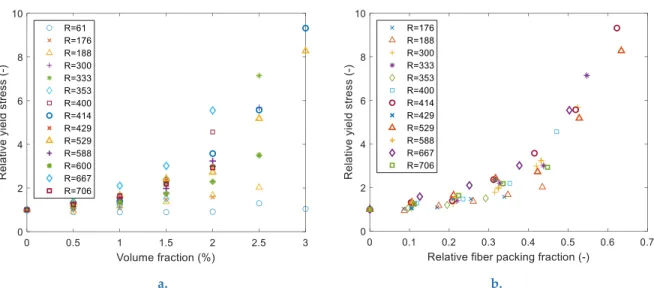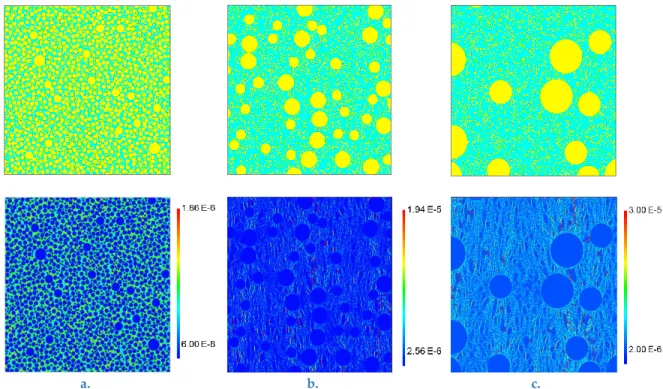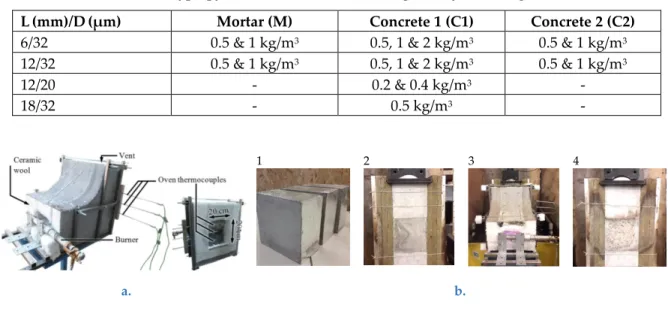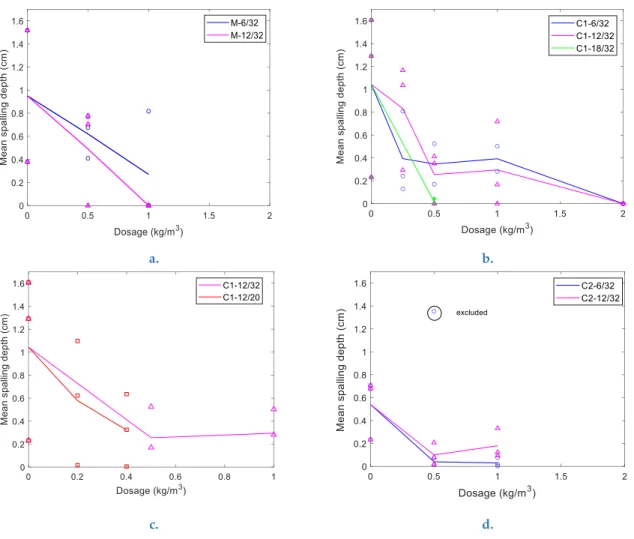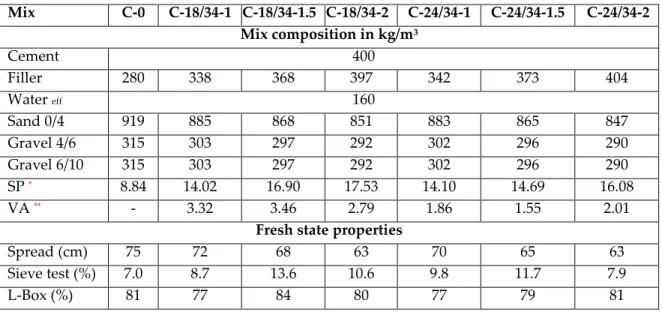Design of fire resistant self-compacting
concrete containing PP fibers
Fariza Sultangaliyeva1
1 Laboratoire SIAME, E2S UPPA, Université de Pau et des Pays de l’Adour
ABSTRACTPresent paper deals with a challenge of formulating fire resistant self-compacting concrete with polypropylene fibers. Firstly, influence of fiber on fresh state behavior is evaluated and predictive scheme for the yield stress is developed. Secondly, choice of PP fiber geometry is optimized in terms of spalling prevention for three cementitious materials via numerical and experimental works. Lastly, fire resistant self-compacting concrete with PP fibers is designed using conclusions from rheology and fire behaviour.
Mots-clefs polypropylene fibers, spalling, optimization, yield stress, self-compacting concrete
I. INTRODUCTION
It is generally agreed that addition of polypropylene fibers or PP fibers (few kg/m3) is beneficial in
terms of spalling prevention due to fire; however, has a major drawback in reducing flowability of fresh concrete. Two important issues rise when it comes to designing self-compacting concrete with PP fibers: influence of these fibers on fresh state is not well understood and works on PP fibers for fire protection do not provide clear guidelines for an optimized PP fiber choice.
Increase of fiber volume fraction ϕf induces an increase of the yield stress τ0 (a minimum stress
value necessary for material flow). For steel fibers, the yield stress of cementitious materials scales with a fiber factor ϕfR (Martinie, Rossi and Roussel, 2010) where R is an aspect ratio (a ratio of
fiber length L and diameter D). PP fibers, on contrary, are flexible fibers that bend under the stresses exerted by suspending medium and their influence on the yield stress is far less studied. Meanwhile, several works have dealt with studying influence of PP fibers on high temperature concrete properties and fire spalling; however, due to a variety of testing condition, composition, heating, etc., an optimal PP fiber choice is quiet hard to identify. Generally, increase of PP fiber dosage and length has decreased spalling (Bilodeau, Kodur and Hoff, 2004). Fiber diameter, at same fiber number, seemed to have no significant influence on spalling (Heo et al., 2012).
This paper presents the work on formulation of fire resistant self-compacting concrete containing PP fibers. At first, yield stress measurements of cement pastes with PP fibers are conducted and physical model for predicting yield stress of cement-based composites is developed. An additional volume of paste that would allow retrieving fluidity of PP fiber reinforced concrete is determined. Then, choice of PP fiber geometry is optimized for three cementitious materials (mortar, concrete 1 and concrete 2) to avoid spalling due to fire with numerical simulations and
fire tests. Finally, conclusions from rheology and fire behaviour are applied to a design of fire resistant self-compacting concrete with PP fibers.
II. RHEOLOGY
Cement pastes with W/C=0.5 are prepared using CEM I from Brest. PP fiber geometries are varied from R=61 to R=706 (Sultangaliyeva et al., 2020). Yield stress measurements are accomplished using method developed by (Roussel, Stefani and Leroy 2005).
Yield stress evolves as a function of the yield stress of reference paste τ00 and ratio of volume
fraction ϕand maximum packing fraction ϕm of inclusions, thus, results are presented in terms of
relative yield stress, a ratio of the yield stress of paste with fibers τ0 and the yield stress of
reference paste τ00= 20 Pa.
(1) Relative yield stress is plotted as function of PP fiber dosage in Figure 1a. The yield stress increases with fiber volume fraction ϕf; however, does not evolve as a function of aspect ratio R
(as for steel fibers).
PP fibers are flexible fibers and can be viewed as a chain of N rigid segments with length L0 that
do not cross each other, i.e. self-avoiding walk. Effective length Leff of the chain is L0N3/5 (de
Gennes 1979). Maximum packing fraction for PP fibers is found as (Sultangaliyeva et al., 2020): (2)
where E is elastic modulus of polypropylene = 1 GPa. Using equation 2, master curve is then plotted in Figure 1b, showing a good agreement.
Fibers are generally present with aggregates in the system. Total relative packing fraction of inclusions can be represented as a linear sum of contributions of aggregates and fibers, where ϕa
and ϕma are aggregate volume fraction and aggregate maximum packing fraction:
(3) Influence of PP fibers on the rheology can then be limited by removal of volume of aggregates ϕa
and addition of supplementary paste:
(4)
Developed physical model can predict the evolution of the yield stress of cementitious suspension containing PP fibers and can allow formulating self-compacting concrete with PP fibers.
a. b.
FIGURE 1. Relative yield stress τ0/τ00 as a function of volume fraction ϕf (a) and relative fiber packing
fraction ϕf/ϕfm (b).
III. OPTIMIZATION OF PP FIBER CHOICE 1. Cementitious materials
Optimization of PP fiber geometry is conducted for three cementitious materials presented in Table 1: mortar, concrete 1 and concrete 2. The materials have different granular skeletons selected in order to achieve different cracking patterns. Granular skeleton of mortar is composed of 100 % sand 0/1, concrete 1 and concrete 2 are made of 40 % sand 0/1 and 60 % gravel 6.3/10 or 60 % gravel 14/20. Siliceous sand (density: 2650 kg/m3) and calcereous gravels (density: 2650 and
2680 kg/m3) are used. Cement is CEM III/A from Heming, siliceous filler from Sibelco and
superplasticizer is Viscocrete Krono 26 from SIKA. Mean compressive strength at 28 days is 41, 90 and 80 MPa for mortar, concrete 1 and concrete 2 respectively.
TABLE 1. Mix composition for three materials in kg/m3.
Material Cement Water eff Filler Sand 0/1 Gravel 6.3/10 Gravel 14/20 SP* Mortar 500 200 120 1557 - - 10 Concrete 1 623 945 - 3.75 Concrete 2 623 - 952 2 *superplasticizer 2. Numerical simulations
Two dimensional mesoscale thermo-mechanical simulations of three materials under 5 MPa compression have been conducted in Cast3m. Thermo-mechanical model used is based on mechanical model from Fichant-La Borderie (1999) with a thermo-mechanical coupling, which takes into account thermal strains (La Borderie, Lawrence and Menou 2007). Crack opening is computed with a method presented in (La Borderie, Maurel and Matallah, 2009), considering the effects of non-linear thermal expansion.
Mesostructure is constructed using an arbitrary draw and only aggregates larger than 1 mm are drawn (Nguyen 2010). Meshes obtained for three materials are presented in Figure 2. Aggregates and cement paste use the same numerical model and material properties are projected on Gauss points (Nguyen 2010). The evolution of material properties with temperature is acquired from literature (Carré 2011, Hager 2004, Menou et al., 2006). Two dimensional plane stress simulations are accomplished with symmetry in x and y-axis. Uniform temperature is imposed over the mesh. As a result, crack opening at 350 °C for three materials is presented in Figure 2 (NB: color scale is different for each material). The results show that cracking is governed by maximum size of aggregates. For mortar (Dmax= 1 mm, Figure 2a), cracks are diffused, while for concrete 1 (Dmax= 10
mm, Figure 2b) cracks are less open and less distant compared to concrete 2 (Dmax= 20 mm, Figure
2c). It appears that crack spacing and crack opening increase with aggregate size.
PP fibers are introduced into concrete mix to improve percolation of water vapor transport channels, thus, reducing risk of spalling and one of the ways to achieve it is through bridging thermally induced cracks. Results show that increase of aggregate size increases crack spacing, consequently, optimized PP fiber length to connect cracks should increase with the aggregate size.
a. b. c.
FIGURE 2. Meshes and crack opening (in m) at 350 °C for mortar (a), concrete 1 (b) and concrete 2 (c).
3. Fire tests
Three cementitious materials (mortar, concrete 1 and concrete 2) containing various PP fiber geometries and dosages presented in Table 2 have been tested in fire under 5 MPa compression (3 samples for each mix). Samples were demolded 24 hours following the casting and stored 59 days underwater. Mean water content is 6.6, 5.6 and 5.5 % for mortar, concrete 1 and concrete 2.
Fire tests are conducted via gas furnace equipped with linear gas burner (butane as a gas) (Figure 3a). Furnace opening is 20 x 20 cm2. Three sheathed K-type thermocouples are placed at 4, 10 and
16 cm from bottom of furnace opening to register temperature evolution 1 cm from heated face. Fire tests are performed on prisms 20 x 20 x 10 cm3 insulated on lateral sides (Figure 3b.1). Test
sample is placed between two fiber reinforced concrete blocks with rock wool insulation on lateral sides and loaded 5 MPa in compression (Figure 3b.2). Gas is opened and burned; ISO 834-1 standard fire curve is followed for 30 min (Figure 3b.3). Heated face of sample after test (Figure 3b.4) is then analyzed for mean and maximum spalling depth as well as spalled volume using photogrammetry (Sultangaliyeva et al.,2019).
TABLE 2. Polypropylene fibers from Baumhüter (geometry and dosage) studied.
L(mm)/D(μm) Mortar (M) Concrete 1 (C1) Concrete 2 (C2) 6/32 0.5 & 1 kg/m3 0.5, 1 & 2 kg/m3 0.5 & 1 kg/m3
12/32 0.5 & 1 kg/m3 0.5, 1 & 2 kg/m3 0.5 & 1 kg/m3
12/20 - 0.2 & 0.4 kg/m3 -
18/32 - 0.5 kg/m3 -
1 2 3 4
a. b.
FIGURE 3. Fire test furnace (a) and fire test procedure (b).
The results in Figure 4 present mean spalling depth (spalled volume over heated surface) as function of PP fiber dosage for mortar, concrete 1 and concrete 2. It is possible to note a dispersion in results, which is mainly related to the small size of samples. Three materials have different compressive strengths, thus, direct comparison should be avoided.
Results show a positive influence of PP fibers on spalling reduction, increase of PP fiber dosage has generally reduced mean spalling depth for all materials. In terms of PP fiber length, for mortar (Figure 4a), 12 mm fibers are more efficient than 6 mm fibers. For concrete 1 (Figure 4b), 18 mm fibers are more efficient than 6 and 12 mm fibers. For concrete 2 (Figure 4d), both 6 and 12 mm lengths are not completely efficient in spalling prevention. It appears that optimized PP fiber length increases with aggregate size: 12 mm for mortar (Dmax= 1 mm) and 18 mm for concrete 1
(Dmax=10 mm). This finding is in agreement with numerical simulations. The influence of PP fiber
diameter is studied at same fiber number for 20 and 32 μm fibers (Figure 4c) for concrete 1 only and shows no significant influence of fiber diameter on spalling as reported in (Heo et al., 2012). This optimization work provides some guidelines for PP fiber choice:
PP fiber length = function (granular skeleton) No influence of PP fiber diameter.
a. b.
c. d.
FIGURE 4. Mean spalling depth as a function PP fiber dosage for mortar (a), concrete 1 (b-c) and
concrete 2 (d).
IV. MIX DESIGN
Conclusions from rheology and fire resistance are essential for a formulation of self-compacting and fire resistant concrete. PP fibers with length of 18 and 24 mm (D=34 μm) are selected as an optimized fiber lengths for high performance concrete with Dmax = 10 mm at dosages of 1, 1.5 and
2 kg/m3. Same cement and filler have been used. Calcareous aggregates 0/4, 4/6 and 6/10 are from
Calin (density: 2540, 2610 and 2620 kg/m3). Superplasticizer is Optima 145 and viscosity agent is
Plast V90 from Chryso.
Fiber reinforced mixes are adjusted to account for influence of PP fibers (Sultangaliyeva et al., 2020) with a supplementary volume of paste. Mean compressive strength of C-0 and C-24/34-2 at 28 days is 90 and 92 MPa respectively. Composition and fresh state properties for final mixes are presented in Table 3. It is possible to note that final mixes satisfy self-compacting concrete requirements in terms of fresh state properties.
Final mixes have been tested in fire under a higher compression load of 20 MPa (result of simulations, not presented here). Prisms have been stored 7 days in water and 82 days in 75 %
relative humidity. Overall mean water content is 4.6 %. The results of mean spalling depth summarized in Table 4 show that no spalling has occurred for mixes containing 1.5 and 2 kg/m3 of
fibers, while spalling occurred for a reference mix and 1 kg/m3 of fibers. It appears that at 1 kg/m3,
18 mm fibers are slightly more efficient than 24 mm fibers due to a higher number of fibers. In general, 18 mm long fibers (34 μm) at 1.5 kg/m3 seem sufficient to prevent spalling of high
performance concrete. Results of fresh state properties and fire tests show that this new approach allows formulating fire resistant self-compacting concrete containing PP fibers.
TABLE 3. Composition and properties of final mixes.
Mix C-0 C-18/34-1 C-18/34-1.5 C-18/34-2 C-24/34-1 C-24/34-1.5 C-24/34-2 Mix composition in kg/m3 Cement 400 Filler 280 338 368 397 342 373 404 Water eff 160 Sand 0/4 919 885 868 851 883 865 847 Gravel 4/6 315 303 297 292 302 296 290 Gravel 6/10 315 303 297 292 302 296 290 SP * 8.84 14.02 16.90 17.53 14.10 14.69 16.08 VA ** - 3.32 3.46 2.79 1.86 1.55 2.01
Fresh state properties
Spread (cm) 75 72 68 63 70 65 63
Sieve test (%) 7.0 8.7 13.6 10.6 9.8 11.7 7.9
L-Box (%) 81 77 84 80 77 79 81
* supeplasticizer, ** viscosity agent
TABLE 4. Mean spalling depth (hmean) of samples.
Mix C-0 C-18/34-1 C-18/34-1.5 C-18/34-2 C-24/34-1 C-24/34-1.5 C-24/34-2
hmean (cm) 1.74 0.30 0 0 0.43 0 0
V. CONCLUSIONS
In this paper, design of self-compacting concrete containing PP fibers resistant to spalling due to fire exposure is presented. First, influence of PP fibers on rheological behaviour (the yield stress) of cement pastes is studied. An important contribution of this study is determination of volume of supplementary paste required in PP fiber reinforced concrete mix to limit negative influence of PP fibers on fluidity. Second, optimization of PP fibers for spalling prevention of three materials with different granular skeletons (mortar, concrete 1 and concrete 2) is performed with numerical and experimental studies. It was found that PP fiber length should be selected with respect to aggregate size and that PP fiber diameter has no significant influence. Finally, with final choice of PP fibers, mix design of self-compacting concrete was performed. The results show a possibility of formulating high performance concrete with PP fibers which can be fluid and fire resistant at the same time.
REFERENCES
Bilodeau, A., Kodur, V.K.R. & Hoff, G.C. (2004). Optimization of the type and amount of polypropylene fibres for preventing the spalling of lightweight concrete subjected to hydrocarbon fire. Cement and Concrete Composites, 26 (2), 163-174.
Carré, H. (2011). Mesure de caractéristiques mécaniques à haute température : ε transversales lors d’essais de compression, essais de flexion à haute température. Report CSTB.
de Gennes, P.G. (1979). Scaling concepts in polymer science. Cornell University Press. Fichant, S., La Borderie, C., & Pijaudier-Cabot, G. (1999). Isotropic and anisotropic descriptions of damage in concrete structures. Mechanics of cohesive frictional materials, 4(4), 339– 359. https://doi.org/10.1002/(SICI)1099-1484(199907)4:4%3C339::AID-CFM65%3E3.0.CO;2-J
Hager, G.I. (2004). Comportement à haute température des bétons à hautes performances -évolution des principales propriétés mécaniques (PhD Thesis). Ecole nationale des ponts et chaussées et l’école polytechnique de Cracovie.
Heo, Y.S., Sanjayan, J.G., Han, C.G. & Han, M.C. (2012). Limited effect of diameter of fibres on spalling protection of concrete in fire. Materials and Structures 2012, 45, 325-335. https://link.springer.com/content/pdf/10.1617/s11527-011-9768-z.pdf
La Borderie, C., Lawrence, C. & Menou, A. (2007). Approche mésoscopique du comportement du béton : Apport de la représentation géométrique. Revue Européenne de Génie Civil, 11(4), 407-421. https://doi.org/10.1080/17747120.2007.9692936
La Borderie, C., Maurel, O. & Matallah, M. (2009). Couplage endommagement fissuration : application aux calculs de structures en béton armé. 19th Congrès Français de Mécanique, 1-6. http://documents.irevues.inist.fr/bitstream/handle/2042/36973/936.pdf
Martinie, L., Rossi, P. & Roussel, N. (2010). Rheology of fiber reinforced cementitious materials: classification and prediction. Cement and Concrete Research, 40 (2), 226-234. https://doi.org/10.1016/j.cemconres.2009.08.032
Menou, A., Mounajed, G., Boussa, H., Pineaud, A. & Carré, H. (2006). Residual fracture energy of cement paste, mortar and concrete subject to high temperature. Theoretical and Applied Fracture Mechanics, 45 (1), 64-71. https://doi.org/10.1016/j.tafmec.2005.11.007
Nguyen, T.D. (2010). Apport de la modélisation mésoscopique dans la prédiction des écoulements dans les ouvrages en béton fissuré en conditions d’accident grave (PhD Thesis). Université de Pau et des Pays de l’Adour.
Roussel, N., Stefani, C. & Leroy, R. (2005). From mini-cone test to Abrams cone test: measurement of cement-based materials yield stress using slump tests. Cement and Concrete Research, 35 (5), 817-822. https://doi.org/10.1016/j.cemconres.2004.07.032
Sultangaliyeva, F., Fernandes, B., Carré, H., La Borderie, C., Pimienta P. & Roussel, N. (2019). Experimental contribution to the optimization of the choice of polypropylene fibers in concrete for its thermal stability. 6th International Workshop on Concrete Spalling due to Fire Exposure. https://hal.archives-ouvertes.fr/hal-02946253/document
Sultangaliyeva, F., Carré, H., La Borderie, C., Zuo, W., Keita, E. & Roussel, N. (2020). Influence of flexible fibers on the yield stress of fresh cement pastes and mortars. Cement and Concrete Research, 138, 1-7. https://doi.org/10.1016/j.cemconres.2020.106221
